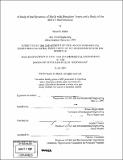| dc.contributor.advisor | Klaus-Jürgen Bathe. | en_US |
| dc.contributor.author | Malek, Samar R. (Samar Rula) | en_US |
| dc.contributor.other | Massachusetts Institute of Technology. Dept. of Civil and Environmental Engineering. | en_US |
| dc.date.accessioned | 2007-10-22T17:30:12Z | |
| dc.date.available | 2007-10-22T17:30:12Z | |
| dc.date.copyright | 2007 | en_US |
| dc.date.issued | 2007 | en_US |
| dc.identifier.uri | http://hdl.handle.net/1721.1/39281 | |
| dc.description | Thesis (S.M.)--Massachusetts Institute of Technology, Dept. of Civil and Environmental Engineering, 2007. | en_US |
| dc.description | Includes bibliographical references (leaf 63). | en_US |
| dc.description.abstract | Shell structures are frequently used for their aesthetic appeal, and material efficiency. They can be found everywhere, in all sorts of contexts. For example, they can serve as roofs to encapsulate large areas (think Millennium Park in Chicago); as fuselage for an airplane; as the frame of a car; as chemical containers (such as pressure vessels); even submarines. One of the most challenging phenomena in shells is boundary layers. Boundary layers are high concentrations of energy due to either irregular loadings, or incompatible boundary conditions, or geometric discontinuities. Previous studies have determined the location of this concentrated energy and how that location varies depending on the thickness of the shell; up to now however, any correlation between the boundary layers and the vibrations of the shell has not yet been examined. In our first study, we review the boundary layer behavior, and we investigate the dependence of the shell's natural frequencies on the boundary layer phenomenon for two shell benchmark problems: the Scordelis-Lo Roof and the Clamped Hyperboloid. | en_US |
| dc.description.abstract | (cont.) In our second study, we shortly review the MITC3 shell element. This element is known to lock in plate bending cases for a specific mesh pattern. Finally, we formulate a new MITC triangular, four node element and investigate its plate bending behavior in detail. Our results show that including an extra node in the center of the element does not improve the plate bending behavior. We discuss our results and make suggestions for future investigations. | en_US |
| dc.description.statementofresponsibility | by Samar R. Malek. | en_US |
| dc.format.extent | 63 leaves | en_US |
| dc.language.iso | eng | en_US |
| dc.publisher | Massachusetts Institute of Technology | en_US |
| dc.rights | M.I.T. theses are protected by copyright. They may be viewed from this source for any purpose, but reproduction or distribution in any format is prohibited without written permission. See provided URL for inquiries about permission. | en_US |
| dc.rights.uri | http://dspace.mit.edu/handle/1721.1/7582 | |
| dc.subject | Civil and Environmental Engineering. | en_US |
| dc.title | A study of the dynamics of shells with boundary layers and a study of the MITC3 shell element | en_US |
| dc.title.alternative | Study of the MITC3 shell element | en_US |
| dc.type | Thesis | en_US |
| dc.description.degree | S.M. | en_US |
| dc.contributor.department | Massachusetts Institute of Technology. Department of Civil and Environmental Engineering | |
| dc.identifier.oclc | 171020655 | en_US |
